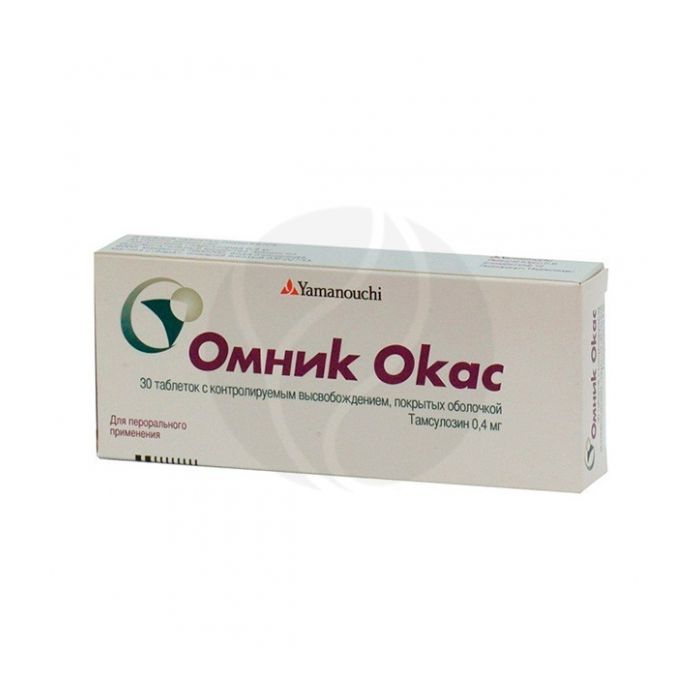Omnik Okas tablets 0.4mg, No. 30
Expiration Date: 05/2027
Russian Pharmacy name:
Омник Окас таблетки 0,4мг, №30
Inside - 400 mcg 1 time / day (after breakfast).
Controlled-release tablets, yellow to brownish-yellow film-coated, round, biconvex, '04' embossed on one side.
1 tab. tamsulosin hydrochloride 400 mcg
Excipients: macrogol 8000 - 40 mg, macrogol 7,000,000 - 200 mg, magnesium stearate - 1.2 mg.
Hypersensitivity to tamsulosin.
pharmachologic effect
Blocker? 1-adrenergic receptors; a remedy for the symptomatic treatment of benign prostatic hyperplasia.
Selectively blocks postsynaptic ? 1A-adrenergic receptors of smooth muscles of the prostate gland, bladder neck, prostatic urethra. As a result, the tone of the smooth muscles of these formations decreases, and the outflow of urine is facilitated. At the same time, the symptoms of obstruction and irritation associated with benign prostatic hyperplasia are reduced. The therapeutic effect appears approximately 2 weeks after the start of treatment.
The ability to block ?1B-adrenergic receptors of vascular smooth muscles is much less pronounced in tamsulosin, therefore the effect on systemic blood pressure is insignificant.
Pharmacokinetics
After oral administration, tamsulosin is rapidly and almost completely absorbed from the gastrointestinal tract. After a single oral intake of 400 ?g, the Cmax of the active substance in plasma is reached after 6 hours.
Plasma protein binding - 99%. Vd is insignificant and amounts to 0.2 l / kg.
Tamsulosin is slowly metabolized in the liver with the formation of pharmacologically active metabolites that retain a high selectivity for ?1A-adrenergic receptors. Most of the active substance is present in the blood unchanged.
T1 / 2 of tamsulosin with a single dose - 10 hours, terminal T1 / 2 is - 22 hours. It is excreted by the kidneys, 9% - unchanged.
Side effect
From the side of the cardiovascular system: rarely - dizziness, orthostatic hypotension, palpitations.
From the side of the central nervous system: headache, asthenia are possible.
From the reproductive system: rarely - retrograde ejaculation.
Application for violations of liver function
Use with caution in patients with severe liver dysfunction.
Application for impaired renal function
In patients with impaired renal function, changes in the dosage regimen are not required.
special instructions
Use with caution in patients prone to arterial hypotension, with severe liver dysfunction.
Before starting tamsulosin therapy, the patient should be examined for other diseases that can cause the same symptoms as benign prostatic hyperplasia. Before starting treatment and regularly during therapy, a digital rectal examination should be performed and, if required, the determination of a specific antigen of the prostate. In patients with impaired renal function, changes in the dosage regimen are not required.
Influence on the ability to drive vehicles and use mechanisms
During the period of treatment, it is necessary to refrain from engaging in potentially hazardous activities that require increased concentration of attention and speed of psychomotor reactions.
Drug interactions
With the simultaneous use of tamsulosin with cimetidine, there was a slight increase in the concentration of tamsulosin in the blood plasma, and with furosemide, a decrease in the concentration; with other? 1-blockers - a pronounced increase in the hypotensive effect is possible.
Diclofenac and indirect anticoagulants slightly increase the rate of tamsulosin elimination.
Diazepam, propranolol, trichloromethiazide, chlormadinone, amitriptyline, diclofenac, glibenclamide, simvastatin and warfarin do not alter the free fraction of tamsulosin in human plasma in vitro. In turn, tamsulosin also does not change the free fractions of diazepam, propranolol, trichloromethiazide and chlormadinone.
In vitro studies, no interaction was found at the level of hepatic metabolism with amitriptyline, salbutamol, glibenclamide and finasteride.
Other? 1-blockers, acetylcholinesterase inhibitors, alprostadil, anesthetics, diuretics, levodopa, antidepressants, beta-blockers, slow calcium channel blockers, muscle relaxants, nitrates and ethanol can increase the severity of the hypotensive effect.

